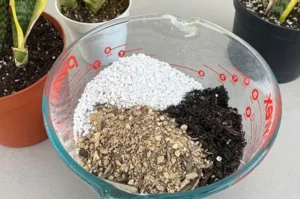Snake plants (Sansevieria, also known as mother-in-law’s tongue) are famous for being tough, low-maintenance houseplants. But even the most independent plants need a little help now and then. One task that often gets overlooked? Replanting.
You might think, “It looks fine… why bother?”
But skipping this important step can quietly damage your plant over time.
In this article, we’ll break down:
- Why replanting matters
- What actually happens if you don’t do it
- When to replant
- How to replant it properly
Let’s dive in!
Why Replanting a Snake Plant Is Important
Replanting (or repotting) helps:
- Refresh old, nutrient-depleted soil
- Give growing roots more space
- Prevent root rot and disease
- Improve water drainage and airflow
- Boost long-term plant health and appearance
If you skip it for too long, your snake plant might start showing subtle (or dramatic) signs of stress.
What Happens If You Don’t Replant a Snake Plant?
Here’s what can go wrong if your snake plant stays in the same pot for too long:
1. Root-Bound Growth
Snake plants naturally spread through underground rhizomes. If they don’t have enough room, roots start circling the pot, becoming root-bound.
Result:
- Poor water absorption
- Stunted growth
- Risk of roots breaking through the pot
2. Soil Compaction and Poor Drainage
Over time, soil breaks down and becomes compacted. It may also lose its ability to drain well, leading to soggy roots.
Result:
- Increased risk of root rot
- Leaves may droop or turn yellow
- Foul smell from the roots
3. Nutrient Deficiency
Old soil runs out of nutrients, especially if you haven’t been fertilizing regularly.
Result:
- Slower growth
- Pale or dull leaves
- Weak overall plant health
4. Overcrowding
If your snake plant has been growing for a few years, chances are it’s outgrowing the pot.
Result:
- Pot may crack or warp
- Plant could tip over
- Roots may grow out of drainage holes
5. Pest & Fungal Problems
Old, compacted, and soggy soil can invite pests like fungus gnats or soil-borne diseases.
Result:
- Wilting
- Leaf spots
- Infestation
When Should You Replant a Snake Plant?
You should consider replanting your snake plant every 2–3 years, or when you notice signs like:
- Roots growing out of the drainage holes
- Soil drying out too fast
- The pot is cracked or distorted
- Leaves tipping over or becoming top-heavy
- You haven’t changed the soil in years
How to Replant a Snake Plant (In Case You’re Late!)
If your plant is already showing signs of stress, don’t worry — it’s not too late. Here’s a quick rescue guide:
What You’ll Need:
- A pot 1–2 inches wider than the current one (with drainage holes)
- Well-draining soil (cactus or succulent mix)
- Gloves, a small shovel or trowel
- Clean scissors or pruning shears
Step-by-Step Replanting:
- Gently remove the plant from its old pot by tilting it sideways and loosening the soil.
- Inspect the roots—trim any mushy, brown, or rotten parts.
- Fill the new pot with fresh soil, add a drainage layer (optional), and plant your snake plant in the center.
- Cover the roots with soil and leave 1 inch from the top. Press lightly to secure.
- Wait 3–5 days before watering to let any root wounds heal.
Bonus Tip: Should You Divide a Snake Plant While Replanting?
Yes, if it’s large and has multiple shoots, you can divide it into smaller sections and propagate them in new pots. It’s a great way to expand your indoor plant family!
Conclusion
Ignoring replanting might not kill your snake plant overnight but over time, it can lead to root-bound stress, poor growth, and even plant death.
The good news? Replanting is simple, and doing it every couple of years keeps your snake plant healthy, vibrant, and growing strong. If your plant’s looking tired or outgrowing its home, take it as a sign it’s time for a fresh start.






